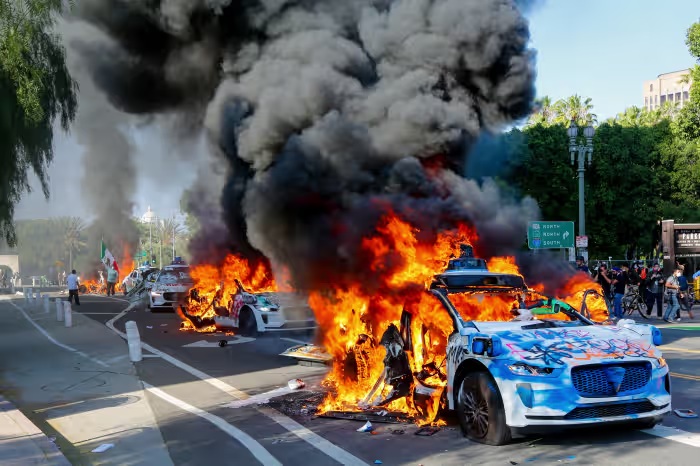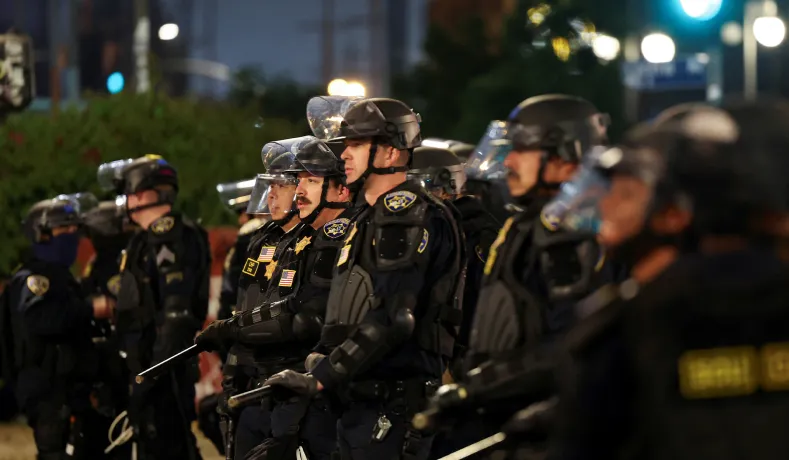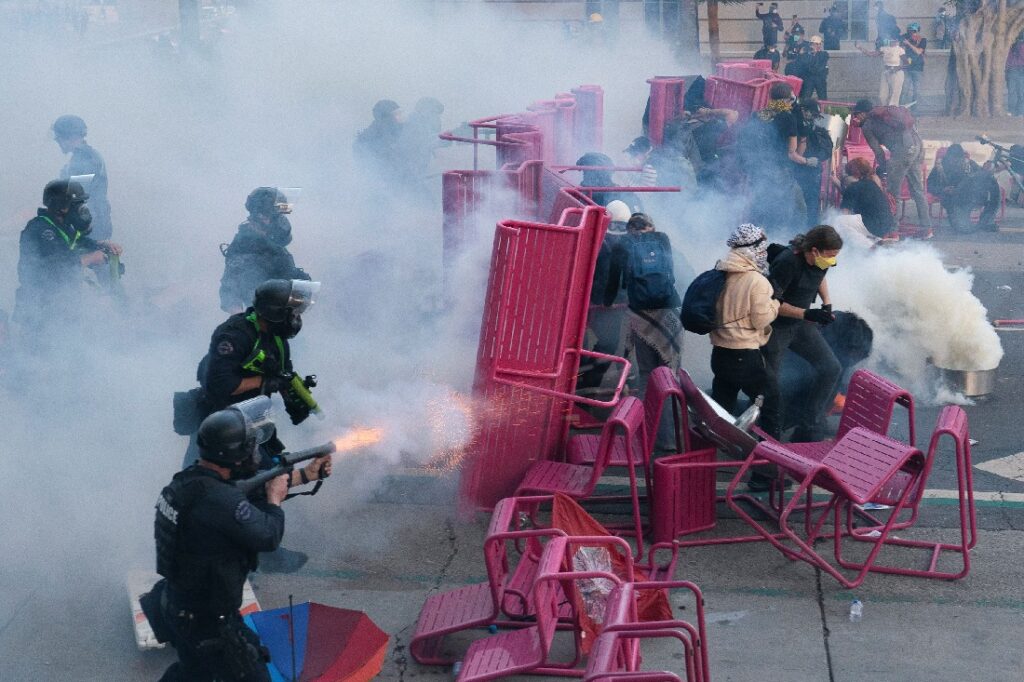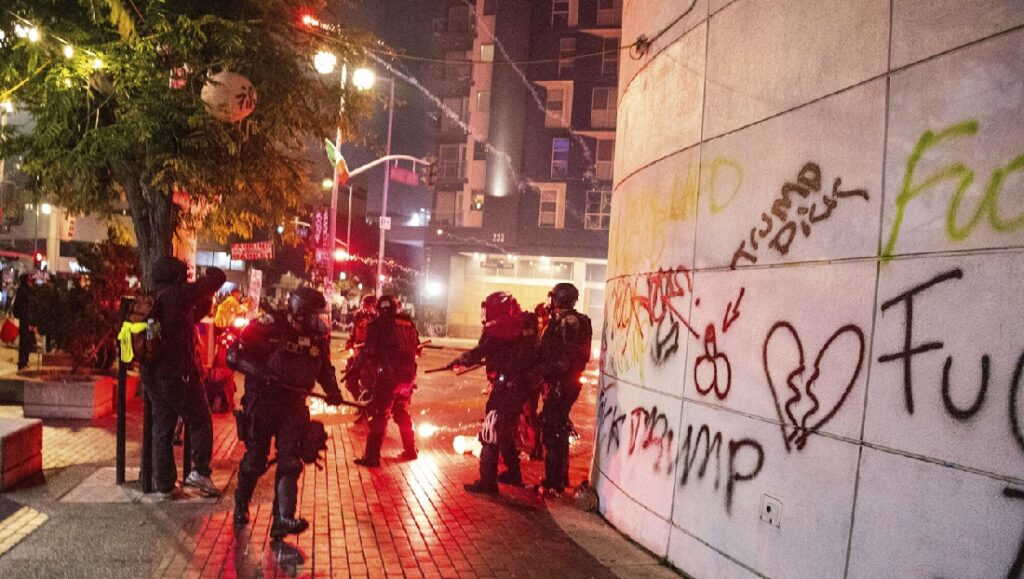Los Angeles is engulfed in turmoil as Los Angeles riots flare in response to ICE immigration raids in the city’s Fashion and garment districts.
In the United States, cities across the country remain on edge amid the ongoing riots. What began as immigration protests in downtown LA has escalated into a national crisis, exposing fault lines between federal and local authorities, and raising urgent questions about democracy, law enforcement, and civil rights.
From Los Angeles to the Nation
It’s day five of the Los Angeles riots, and the turbulence gripping California’s largest city is spreading far beyond its borders. What began as a series of demonstrations over immigration raids in Los Angeles has snowballed into a wave of protests that now ripple through the streets of New York, Chicago, Austin, Dallas, and Tampa. America is on edge, and the rest of the world is watching.
President Donald Trump isn’t backing down—instead, he’s doubling down. Rather than retreat, his administration is flooding Los Angeles with security personnel. But these aren’t ordinary law enforcement officers. These are active duty Marines—some 700 of them—stationed at a California base, already en route to downtown LA. This is no small show of force, and the arrival of the Marines is being framed as a turning point in how the U.S. government responds to civil unrest. Reports say they’ll arrive by Tuesday night, signaling that the crisis in Los Angeles is now a matter of national urgency.
Downtown LA: At the Heart of the Storm
To understand the intensity of the Los Angeles riots, you have to look at the epicenter: the downtown corridors near detention centers and courthouses. Here, hundreds of migrants are being held, and the protests have swelled outside these very buildings. On one side, crowds of protesters—angry, desperate, often defiant. On the other, rows of fully kitted riot cops, their shields reflecting city lights, ready for confrontation.
The scale of the law enforcement response is staggering. More than 4,000 National Guard troops, essentially a reserve military force, have been deployed. Over 700 active duty Marines, along with 800 additional police officers, now patrol the city. That’s more boots on the ground than in many overseas deployments. Residents of Los Angeles say they’ve never seen firepower like this on their own streets. Heavily armed security forces march past boarded-up storefronts, and mounted police are posted near government buildings.
For many Angelenos, the presence is both unsettling and surreal. The city feels less like a hub of entertainment and business, and more like a city under occupation. The National Guard, police, and now the Marines—each representing a different layer of federal and local control—are walking the same streets where, only days earlier, life had been relatively normal.
From Protest to Los Angeles Riots
The Los Angeles riots were ignited by a new round of deportation raids, ordered by the federal government and carried out with a force and speed that shocked many. By Friday evening, thousands were demonstrating across downtown, blocking intersections, waving signs, and demanding change. The protests were sparked by images of families being separated, children watching as parents were taken away, and stories circulating on social media of masked agents arresting people without explanation.
By nightfall, what began as peaceful protest morphed into chaos. Looting and vandalism broke out. Storefronts were smashed, businesses ransacked, and cars set ablaze. LAPD reported more than 500 arrests in the first days alone. At least five police officers have been injured in clashes with demonstrators. Even journalists have found themselves in the line of fire—on Tuesday, a reporter was hit by a less lethal round while documenting the scene.
Mayor Karen Bass responded swiftly, imposing a curfew and declaring a local emergency. “I wanted to let the city know that I have declared a local emergency and issued a curfew for downtown Los Angeles to stop the vandalism, to stop the looting,” she announced. The LAPD, under intense pressure, made mass arrests—at least 25 people were detained overnight for violating the curfew, which covers a dense, one-square-mile patch of central Los Angeles.
The Federal Response
President Trump wasted no time defending his aggressive strategy. Speaking at Fort Bragg, North Carolina, he declared, “I am using every asset at my disposal to restore order. All I want in terms of engagement, I just want to see peace. If there’s peace, we get out. If there’s even a chance of no peace, we stay there until there’s peace.” On social media, his tone was even sharper: “If I didn’t send in the troops, Los Angeles would be burning to the ground.”
The federal government has authorized a massive deployment: 700 active duty Marines joining 4,000 National Guard troops, tasked with protecting federal property, government buildings, and immigration personnel. Photos released by the Marine Corps show soldiers in full riot gear, rehearsing crowd control drills at the Naval Weapons Station in Seal Beach—a clear sign that this is not just a symbolic gesture. The price tag? A staggering $134 million in taxpayer funds, according to Pentagon sources.
But the Marines’ role is controversial. By law, Marines are not permitted to enforce civilian law—unless the President formally invokes the Insurrection Act, a rare and dramatic move usually reserved for the gravest national emergencies. Trump has not taken that step. Instead, the official mission is strictly to guard federal property and personnel. It’s a legal sidestep that has left local officials fuming.
Local Backlash: “We’re an Experiment We Didn’t Ask For”
Inside Los Angeles, political and community leaders are outraged. Critics—including California Governor Gavin Newsom—accuse Trump of using the city as a “political stage” for his own benefit. “This is the behavior of a tyrant, not a president,” Newsom fumed. “California may be first, but it will not end here. Other states are next. Democracy is under assault before our eyes. This moment we have feared has arrived.”
The mayor of Los Angeles, echoing the governor, questioned both the purpose and the legality of the deployment. “We didn’t need the National Guard. Why on earth? What are they going to do? Do you know what the National Guard is doing now? They are guarding two buildings. So they need Marines on top of it? I don’t understand that. That’s why I feel like we are part of an experiment that we did not ask to be a part of.”
The introduction of federal military personnel without direct coordination with local law enforcement creates huge logistical challenges and risks confusion during critical incidents. In court, the governor’s team moved to block the use of federal troops for policing. But a federal judge declined to halt the intervention immediately. A new hearing is set for Thursday, while the Trump administration faces a deadline to defend its deployment in court.
Echoes of History: 1992 and the Shadow of the Past
The last time Los Angeles saw anything like this was in 1992, during the riots sparked by the Rodney King verdict. Back then, more than 60 people died, over 2,000 were injured, and the city suffered more than a billion dollars in damage. The deployment of Marines on American soil is rare, and the memory of 1992 looms over every decision today.
Yet, as of now, the current Los Angeles riots have not reached that same catastrophic level of violence. Authorities are hoping to contain the unrest before it spirals further. But the scale, militarization, and national political stakes make this a turning point in how civil unrest is handled in America.
Protests Spread Nationwide: From LA to NYC, Atlanta to Seattle
The impact of the Los Angeles riots is not confined to California. Protests against the Trump administration’s immigration raids have erupted in New York, Chicago, Atlanta, Washington, and Seattle. In New York’s Foley Square, thousands rallied against ICE. “I’m here today because there’s been a lot of injustices going on in our country. People are being arrested by agents who don’t wear badges, who wear masks—they’re basically being kidnapped,” said one protester. Another added, “I remember seeing on the news that parents were deported from their kids’ kindergarten graduations. I am an immigrant. I am a woman. I’m a woman of color. I really believe every immigrant should be treated equally.”
These protests, inspired by the images and reports coming out of Los Angeles, have become lightning rods for national debate about immigration, policing, and the role of the federal government.
The Politics of Power and Resistance
Supporters of the administration view the military response as necessary, decisive leadership in the face of potential anarchy. Trump himself has framed the battle as one of order versus chaos. Critics, however, compare the resistance to a “rebel alliance” fighting against presidential overreach—a not-so-subtle reference to Star Wars. For Trump, the deployment is a chance to project strength and resolve. For the opposition, it’s a test of democracy itself.
Also Read: U.S. Senator: America is Heading Toward Dictatorship
“Both sides need to wake up,” said one observer. “This is not a fictional story in space. This is real life. Real people are caught in the middle.” The symbolism is clear: each side wants to claim the mantle of righteousness—either as defenders of order or as heroic resistors of government excess.
What’s Next for Los Angeles—and for America?
As the Los Angeles riots drag on, the city remains under a heavy blanket of tension. The National Guard, Marines, and police continue to patrol the streets, while shopkeepers keep their businesses shuttered. Helicopters buzz overhead, and the threat of renewed violence hangs in the air.
Local officials warn that all it takes is one miscalculation, one stray rubber bullet, for the situation to reignite. As of now, more than 150 people have been arrested in Los Angeles, and at least five officers have been injured. The worst, perhaps, seems to be over for now—but no one is letting their guard down.
The future of the Los Angeles riots—and the national wave of protest they have inspired—remains uncertain. Much depends on whether calm can be restored in LA. If peace returns, the fire may die down across the country. But if violence erupts again, it could spiral outwards, engulfing more cities in chaos.
For many, the question is no longer just about Los Angeles or immigration policy. It’s about the limits of presidential power, the role of the military in civilian life, and the very nature of democracy in America. The world is watching Los Angeles—and wondering what comes next.




